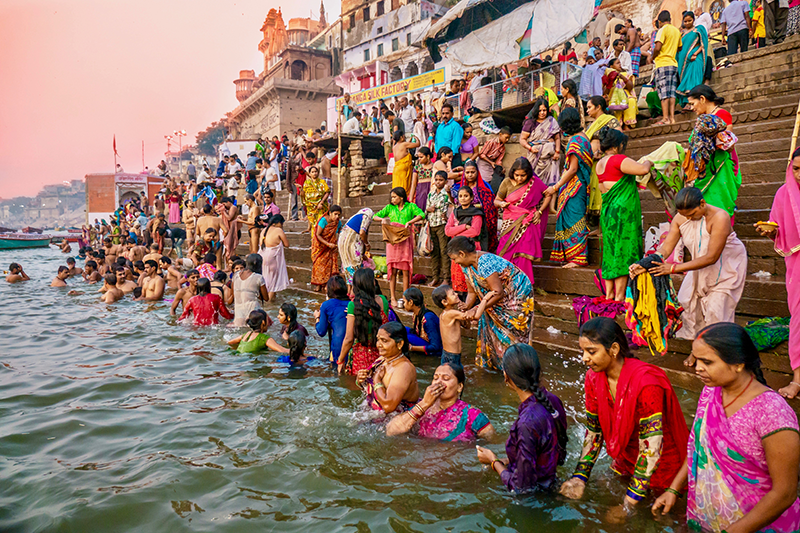Cleaning up the Ganga: $1.5B Mobilized Through Replication of PPPs

Replicating India’s first PPP for wastewater management in the Ganga basin has mobilized over $1.5B, including $650M from the private sector.
The Ganga basin is the world’s most populous river basin, covering 860,000 square kilometers across 11 states in India. More than 600 million people—close to half of India’s population—live within its boundaries, and the region generates over 40% of the country’s GDP. The Ganga River itself flows for about 2,500 kilometers from the Himalayas to the Bay of Bengal, passing through five states along its mainstem. Its waters support agriculture, sustain towns and cities, and hold deep cultural and spiritual significance, with millions visiting the river’s historic banks for religious rites.
Yet, by the mid-2010s, pollution pressures had become acute. Rapid population growth, urbanization, and industrialization outpaced the capacity of existing wastewater infrastructure. Along the Ganga River’s mainstem—home to about 50 major cities—an estimated 3 billion liters of untreated sewage flowed into the river every day. Domestic sewage accounted for the majority of the pollution load, with industrial effluents and poorly managed solid waste adding further pressure. Many existing treatment plants were not functioning effectively or lacked adequate maintenance. Efforts dating back to the 1970s invested billions of dollars to improve sewage management, but results remained limited.
The World Bank-supported National Ganga River Basin Project (NGRBP) began strengthening institutions and financing infrastructure investments in the five mainstem states—Uttarakhand, Uttar Pradesh, Bihar, Jharkhand, and West Bengal. The NGRBP focused on building and upgrading sewage treatment plants, laying new sewer networks, improving environmental governance, and establishing reliable water quality monitoring systems. These foundational steps aimed to restore the river’s health over time.
Within this broader initiative, the 2030 Water Resources Group (WRG) brought in a new dimension: a scalable, performance-based approach to mobilizing private sector participation in wastewater treatment. In 2015, WRG conceptualized and developed a hybrid annuity model (HAM) as a public-private partnership structure for wastewater treatment in the Ganga basin, jointly with the World Bank and the International Finance Corporation. Under HAM, the government pays 40% of the project’s capital costs tied to construction milestones, and the remaining 60% over 15 years, contingent on the treatment plant’s performance. This approach incentivizes the private sector to maintain long-term operational standards and shifts some of the financial risk away from the public sector. It sought to address a persistent challenge: ensuring that treatment plants, once built, continue to function effectively over their entire lifespan.
The initial pilots, launched in Mathura and Vrindavan, as well as Varanasi, and Haridwar, tested the feasibility of this model. These early projects were part of a broader paradigm shift—one that included stakeholder engagement, consultations with local industry for treated wastewater reuse, and alignment among various levels of government. For example, in Mathura, the Indian Oil Corporation agreed to use treated wastewater from the new facility to cool its refinery, reducing reliance on freshwater and demonstrating practical reuse options.
Although these projects were still in their early stages in the late 2010s, their potential was becoming evident. The HAM approach set the stage for attracting multiple bidders to wastewater PPPs in towns like Varanasi and Haridwar, indicating a growing private sector interest. By basing payments on long-term performance rather than upfront construction costs alone, the model aimed to break the cycle of neglected operation and maintenance that had plagued earlier efforts.
As the initial demonstrations proved that private financing, technology, and operational expertise could be secured under suitable conditions, the government moved to replicate the model more widely along the Ganga and beyond. Over time, this approach would be scaled up across numerous cities in the basin, with the World Bank, WRG, and other stakeholders working together to refine contractual frameworks and regulatory policies. Other states and neighboring countries began examining whether a performance-linked PPP model might fit their own wastewater challenges.
Today, the approach pioneered in the Ganga basin is no longer a single-project experiment—it has become a proven model that can be adapted and scaled to other contexts. The pilot phase, which focused on performance-linked financing and the active participation of private investors, paved the way for scaling up. As this model spread beyond its initial sites, it helped mobilize over $1.5 billion in total investments—including $650 million from private sector sources—demonstrating that the right incentives and structures can drive sustained improvements in wastewater treatment.
The success of this approach in the Ganga basin shows that performance-based partnerships can translate challenging water resource projects into viable, long-term investments. What began as a targeted pilot has now become a model with the potential to transform how regions worldwide manage and protect their water resources.
With these lessons now established, other regions and basins can draw on the Ganga experience, adapting and refining the framework to create lasting change in water resource management.
